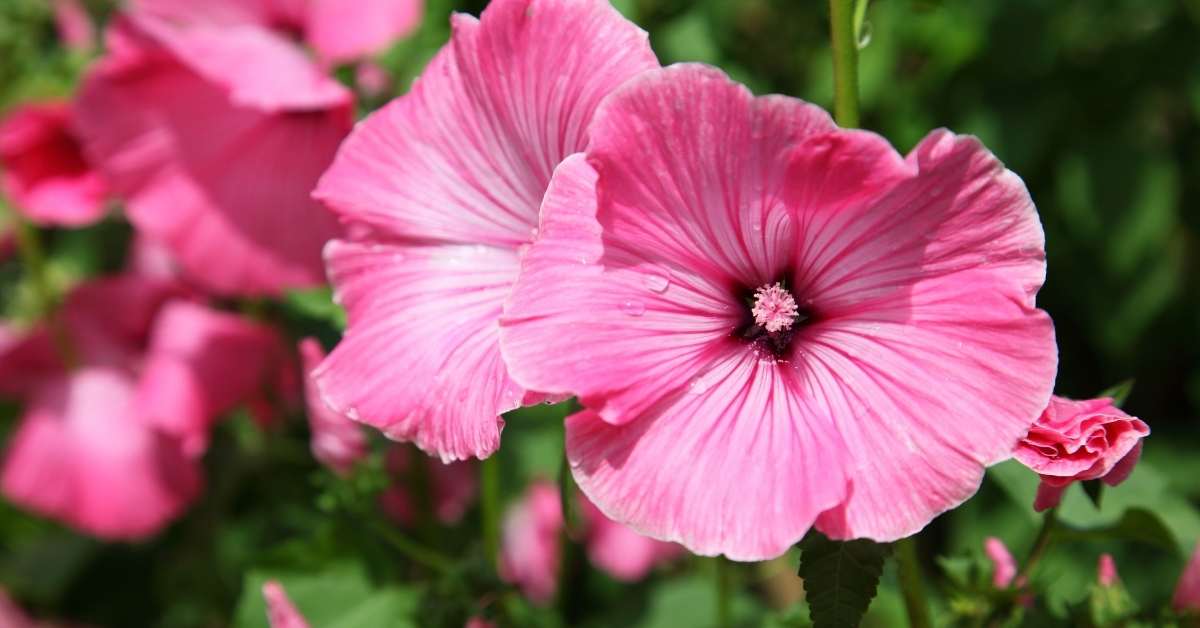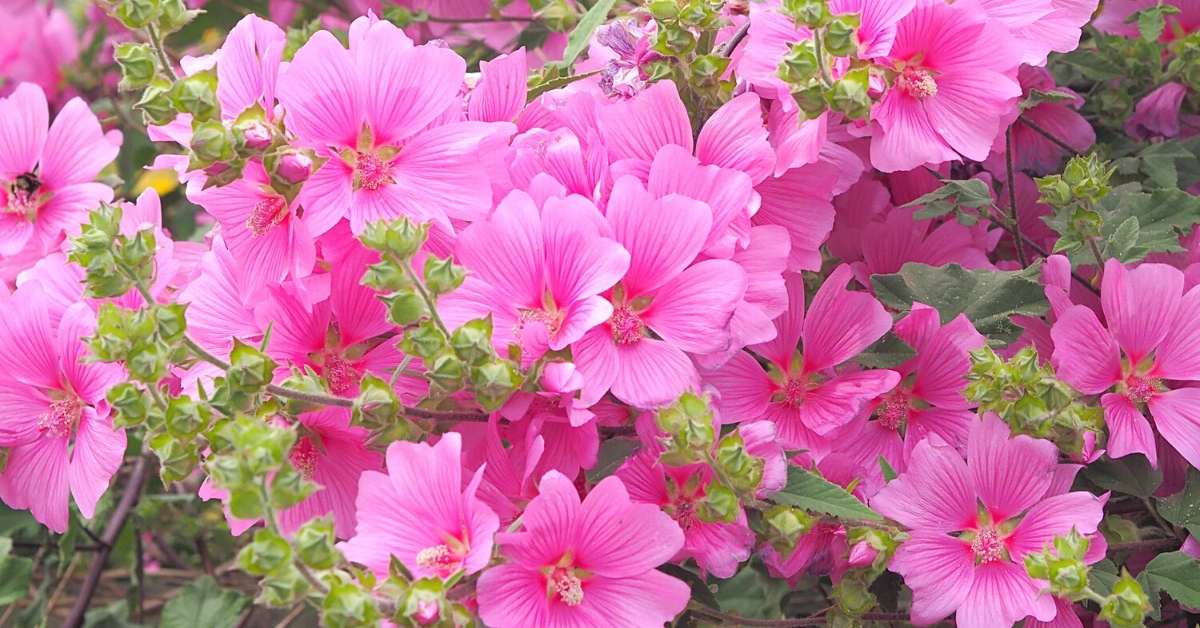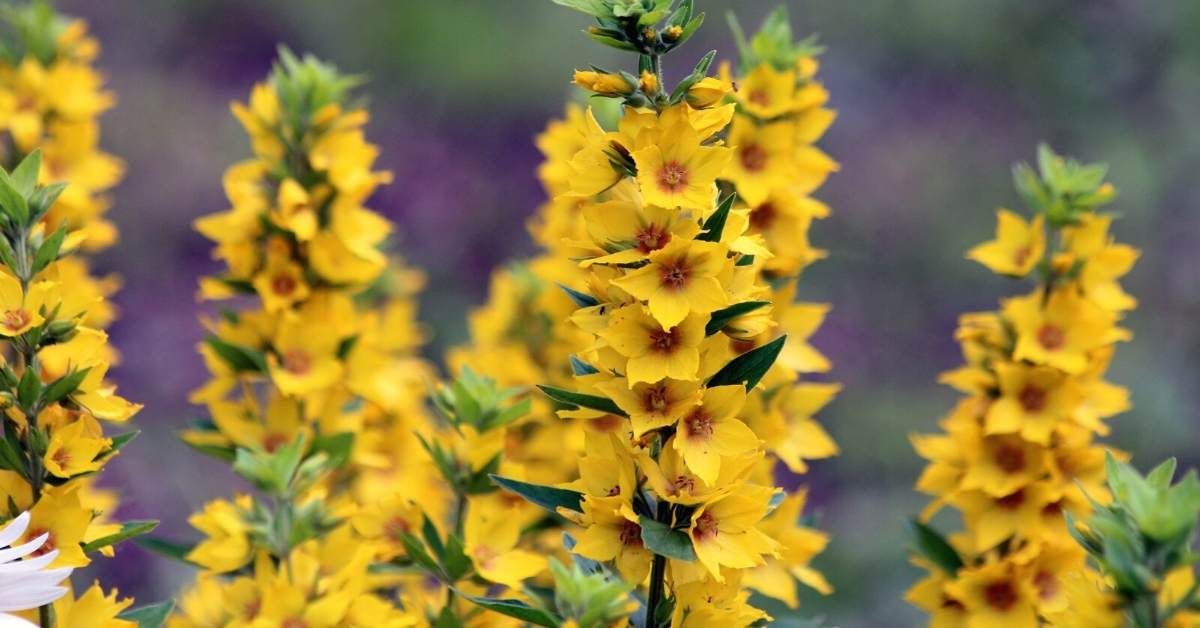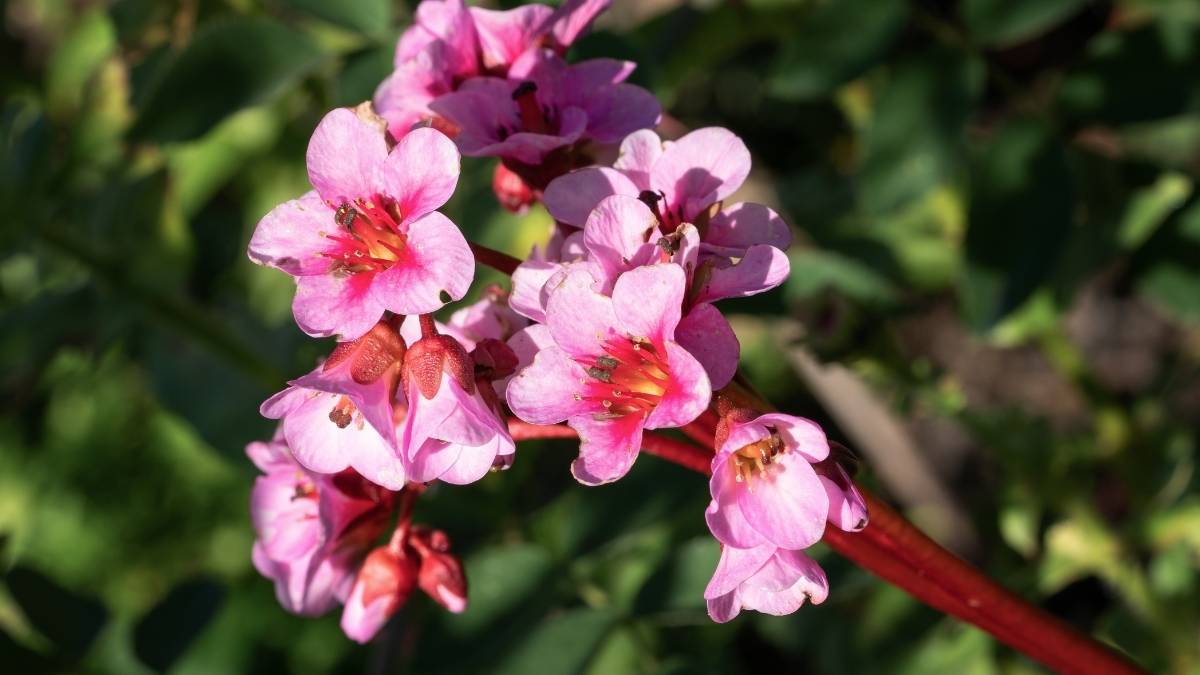I love Lavatera flowers, and as I walked around my gardens this week, I noticed that the various kinds of Lavatera that I have are stunning. Origins It seems that J. R. Lavater, the 17th-century Swiss botanist after whom this plant was named, is widely remembered in my garden.
They are clearly well remembered in their natural habitats of the NW Himalayan Mountains, Eastern Siberia, and even warm Australia.
My perennial plants are covered with freshly produced blooms for a long period of time, even though each individual blossom is short-lived (a day or two at best).
You might want to see this: How to Grow Ajuga Reptans (Bugleweed)
Annual and Perennial Lavatera Flowers
My perennial lavatera plants are not the same as the Lavatera trimestris / trimesters annuals that are often seen at garden centers.
While annual varieties are fascinating, I like perennials that grow in a bushy manner or have tall, straight stalks.
How big does lavatera grow?
If you’re growing annuals, look for ‘Silver Cup,’ a bright pink dwarf bush form that grows to 30 feet tall “Loveliness’ has a trumpet-shaped rose flower that can grow up to 4′ tall, ‘Mont Blanc’ is a dwarf 24″ tall plant with white blossoms, or ‘Pink Beauty’ is a 30” plant with wonderful large pale pink blooms.

Lavatera Plant Problems
All of these beautiful pink blossoms, however, have come at a cost. I had to experiment with various kinds to determine whether they were hardy since the seeds are sluggish and tough to germinate. The tree mallow, L. Arborea, has failed catastrophically twice in its efforts to overwinter.
After two years of excellent health going into the winter, I was left with a grey-brown mound of mushy roots in my garden the following spring. I suppose this plant didn’t enjoy the cold winters in Eastern Ontario.
I believe that if I were to seek this plant again, I would attempt to keep it alive by wintering it inside or in a greenhouse to atone for my previous errors.
Self-sowing Lavatera variety
The L.cachemiriana, which now self-sows to the point that it may be considered a nuisance, has more than made up for this shortcoming.
This Kashmiri native is very robust in our yard and appears to prefer a sunny location.
It begins as a rosette of leaves, then sends one or two branches upwards to five or six feet in height, covering them with delicate pink flowers that are two inches across.
The 5 lobed petal is a brilliant mid pink that lights up the yard.
It’s also trying hard to colonize under my crab apple tree right now, but it’s not having much luck in this lower-light environment. In a year or two, I’m sure it’ll sprout up someplace else in the garden to attempt to take over that area, and I’ll have to trim it down to three or four plants once again.
Lavatera Star Variety (Lavatera Thuringiaca)
The Lavatera thuringiaca, sometimes known as Tree Lavatera, is the true star of the show.
If we lived in Southern Ohio or Pennsylvania, this might be a hardy shrub. However, it dies down to the ground every winter in my USDA zone 4 gardens.
It puts up a number of branches to 6 or 7 feet in the spring (the older plants now resemble a big forsythia) and covers them with a profusion of the characteristic five-lobed blooms by mid-summer. Flowers Blooms from the Short-Lived Lavatera is short-lived, but with hundreds of buds formed, I’ll have a large display of flowers nearly until the middle of August.
You might want to see this: Root Zone Heating For Greenhouse Crops: What You Need To Know.
In our garden, I currently have two varieties of this shrub. I have both the species and the cultivar ‘Barnsley.’ The newer ‘Barnsley’ has a crimson throat and is a deeper pink than the species. It’s a lovely bloom, and finding it is definitely worth the effort.
‘Aurea’ L. ‘Aurea’ L. ‘Aurea “or Golden Grass When the golden leaves first appear in the spring, Lavatera is a beautiful plant. At the end of the summer, it becomes yellowy green. When it reaches full height, it has the typical pink flowers and is quite a beautiful plant.
L.’ Bredon Springs’ has rose-pink blooms and delicate grey-green foliage that looks great in the perennial border when paired with darker-leaved plants.
I raised L. tauricensis for two years before losing it during a warm, rainy winter, although I must admit that my friends and I debated if it was mislabeled. I’m also searching for a botanically correct source for this. In the experimental bed, it had the same blooming shape as L. thuringiaca and was very spectacular.
Next year, I’ll attempt to get the correct plant by utilizing seed from a German supplier.
All other varieties of Lavatera are for gardens in far warmer climates than my USDA zone 4 gardens in Eastern Ontario.
For perennial species plants, lavatera seed is available from seed suppliers like Chiltern or Thompson and Morgan.

You might want to see this: Growing Great Peonies in Your Garden
Planting Lavatera Seeds
- Use my outside pot technique to start the seed properly.
- Cut the bottom off an old 8″ nursery pot (size isn’t necessary, but 6-8″ is good).
- Place the pot in the ground.
- That phrase appealed to me, but it really means to bury the pot so that just the rim is visible.
- Fill the bottomless pot with either the dirt from the hole or potting soil of high grade.
- Pour a kettle of hot water into the pot gently to sterilize the soil.
- Once the seeds have cooled, put them in a quarter-inch of potting soil.
- Tag the pot so you don’t forget what you’ve planted, then forget about it until the following spring.
- After a winter of hibernation, small Lavatera seedlings with their characteristic maple-like leaves should emerge in May.
It’s a weed if it doesn’t have a maple tree leaf on it, and it can be eradicated.
When to take lavatera cuttings?
Lavatera cuttings obtained in the middle of the summer, around 4 inches (10 cm long) and semi-ripe, may be rooted. Remove any leaves from the cutting’s bottom third. Use rooting hormone and place in multi-purpose compost with sand.
To keep the clippings from drying out, place them in a plastic bag. The leaves are somewhat hairy and can perish if they become too moist.
Is lavatera poisonous?
No. There is no reported incident about Lavatera toxicity. However, it will be wise to be careful with pets. Many of our favorite garden plants, though, are poisonous to our dogs and cats. Hundreds of popular flowers, shrubs, and trees are potentially toxic to cats and dogs, ranging from begonias, clematis, and dahlias to geraniums, lobelia, and marigolds.

